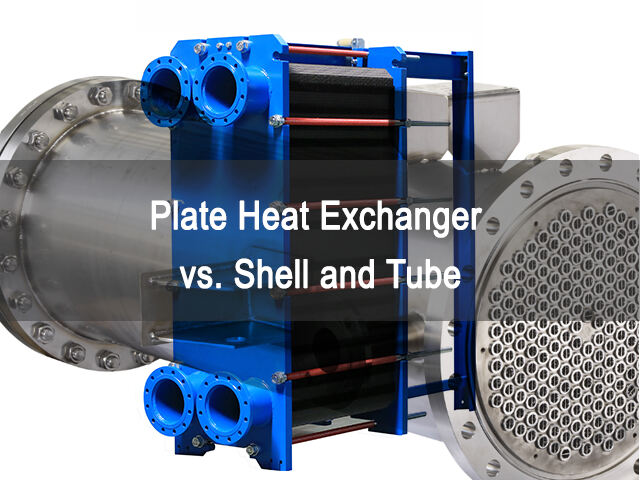A Heat Exchanger is equipment used to transfer heat between two or more fluids. During operation, one fluid releases heat and the other fluid absorbs heat. This process can be various combinations such as water-water, water-oil, water-steam, gas-liquid, etc. Modern industry has higher and higher requirements for energy saving, high efficiency, safety and environmental protection. Heat exchanger is not just a "cooling" or "heating" device. A good heat exchanger can greatly improve production efficiency, reduce energy and waste, and reduce maintenance costs.
Heat exchanger usually includes Plate type and Shell and Tube heat exchanger. In this article, you will learn about plate type vs. shell and tube, their design characteristics, and their differences.
Plate Heat Exchanger is an efficient and compact heat exchange equipment. Its core component is a series of plates stamped into a specific corrugated shape from stainless steel, titanium alloy or other metal materials. These corrugations can not only increase the rigidity of the plate, but more importantly, they can increase the heat exchange area and cause the fluid to form turbulence at low flow rate, thereby enhancing heat transfer. These plates are stacked in a certain order, and the plates are separated by sealing gaskets (for detachable type) or welded/brazed (for welded/brazed type) to form a narrow mesh channel through which cold and hot fluids flow alternately.
Shell and Tube Heat Exchanger is a common industrial heat exchange equipment, which mainly consists of one or more tubes (usually metal tubes) installed in a shell (shell), one fluid (usually hot fluid) flows through the inside of the tube, and another fluid (usually cold fluid) flows through the outside of the tube. The hot fluid transfers heat to the tube wall, and then transfers heat to the cold fluid through the tube wall. Due to the good thermal conductivity of the tube wall, heat can be effectively exchanged between the two fluids.
Due to the flow channel of the plate is narrow and the fluid disturbance is strong. The heat transfer coefficient of PHE is significantly higher than that of the shell and tube type. Effective heat exchange can be achieved at a small temperature difference. Our plates are made of high-grade stainless steel, titanium alloy and other special materials, and are formed in one step by precision molds to ensure that each plate has excellent heat transfer performance.
✅ If you are looking for efficient heat transfer, PHE has more advantages
The plate heat exchanger has a compact, small, and lightweight structure. Under the same heat transfer, its floor space is much smaller than the shell and tube type, which is particularly suitable for occasions with limited space.
✅ When space is limited, PHE is a better choice
Compared with Shell and Tube, the internal flow channel of the plate heat exchanger is narrower, which is not very friendly to viscous or particle-containing fluids. Our wide gap plate heat exchanger perfectly solves this problem and is very suitable for Sugar, Bioethanol, Pulp and paper, Petrochemicals, Condensers for heat recovery, etc.
✅ For high temperature, high pressure or harsh working conditions, it is more reliable to choose the shell and tube type. Our gaskets use high-performance rubber materials (such as EPDM, HNBR, FKM/Viton) and combine them with advanced molding technology to ensure that the rubber pads can provide excellent performance under various working conditions, especially stable and durable performance in high temperature and high pressure environments.
Gasket PHE: Easy to disassemble and assemble, you can easily access all heat exchange surfaces for thorough mechanical cleaning or inspection.
Shell and Tube: Tube cleaning is relatively easy (through gun, chemical cleaning). Shell cleaning is difficult, usually chemical cleaning is used, or the tube bundle needs to be pulled out for physical cleaning.
✅ If frequent cleaning is required, GPHE is more convenient
Plate heat exchangers have lower initial costs, higher energy efficiency, and relatively lower maintenance costs than shell and tube heat exchangers.
✅ Choose PHE for cost-sensitive projects
Gasketed Plate Heat Exchanger: It has good flexibility. The heat exchange area can be adjusted by increasing or decreasing the number of plates to adapt to changes in process conditions or future expansion needs.
Shell and Tube: The heat exchange area is fixed, and once manufactured, its heat exchange capacity cannot be easily changed.
✅ If flexibility is required, the board style is better
| Gasket-Plate | Welded-Plate | Brazed-Plate | Shell and Tube | |
| Heat transfer efficiency | ⭐⭐⭐⭐☆ | ⭐⭐⭐⭐☆ | ⭐⭐⭐⭐☆ | ⭐⭐☆☆☆ |
| Floor space | compact, small, and lightweight | compact, small, and lightweight | compact, small, and lightweight | Bulky and heavy, requiring a large installation space |
| Fluid Compatibility | Medium and low pressure, medium and low temperature | High temperature, high pressure, corrosive fluids | High temperature, high pressure, corrosive fluids | High temperature, high pressure, corrosive fluids |
| Maintenance and Cleaning | easy | hard | hard | hard |
| Cost | Low | Low | Low | High |
| Service life | Medium (gasket replacement required) | Long (sturdy structure) | Long (sturdy structure) | Long (sturdy structure) |
| Flexibility and Scalability | Strong | Weak | Weak | Weak |
